Which Badminton Class Helps Kids Improve Faster? (Malaysia Parents’ Guide)
As a professional badminton coach in Malaysia, the most common question parents ask me revolves around the classic small group vs big group badminton class debate: which setting will truly help their child improve faster and, just as importantly, more safely? The straightforward answer is that small groups generally offer more personalised corrections per child, leading to better technique, enhanced safety, and clearer, more measurable progress. A big group can be effective, but only if it is managed with strong structure and a sufficient number of skilled coaches.
A badminton coach explains how class size affects feedback, safety and progress so Malaysian parents can choose wisely.

Key Factors
Why Badminton Class Size Matters
To make the best decision, parents need to look beyond the price tag and compare key factors: the real badminton coaching ratio for children, the frequency of individual feedback, active court time, and safety protocols. This guide is designed for parents across Kuala Lumpur, including those from Selayang, Kepong, Cheras, Air Panas, and other nearby areas. Ultimately, the ‘best’ choice is not one size fits all; it depends on your child’s age, personality, and goals.
When choosing from the many kids badminton classes in Kuala Lumpur, the size of the group is one of the most critical factors influencing your child’s development speed. It goes far beyond simply learning how to hit a shuttlecock; it’s about receiving consistent, high quality feedback to build correct muscle memory from day one.
A smaller badminton class size for kids almost always translates to more direct coach attention, a higher number of shuttle touches per session, and superior safety supervision. Psychologically, it also plays a huge role. A quieter child will likely thrive and feel more confident in a small group, whereas a social child might draw energy from a larger group dynamic.
The goal is to find a class structured to provide ample personal correction and active court time, with players properly grouped by a similar age and skill level to ensure everyone feels challenged but not overwhelmed.
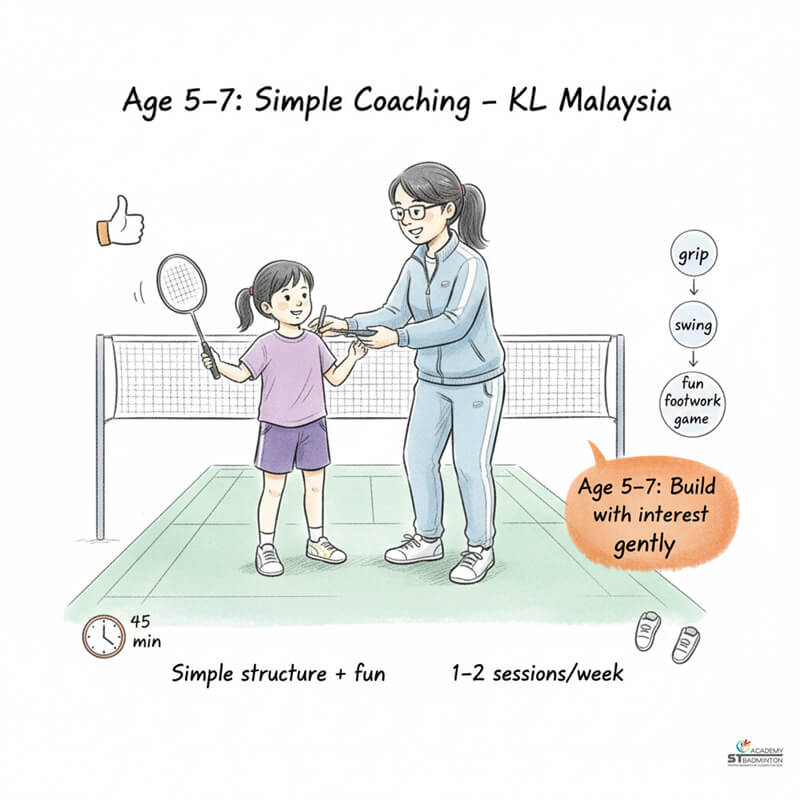
The Focused Approach
What “Small Group” Usually Looks Like
Typically, a small group badminton coaching session in Malaysia consists of approximately 4 to 8 students per court with one dedicated, active coach. This focused environment is excellent for quality learning.
It empowers the coach to do more than just shout general instructions; they have the time to demonstrate a technique, watch each child attempt it, and then provide specific, one on one corrections multiple times. This rapid feedback loop is crucial for fixing subtle errors in grip, stance, or swing before they become deeply ingrained habits.
This format is particularly beneficial for beginners (ages 5 to 10), more reserved children who need encouragement, and any player focused on refining fundamental techniques. It is also far easier for a coach to manage the group, maintain discipline, and ensure every child is moving safely and purposefully.
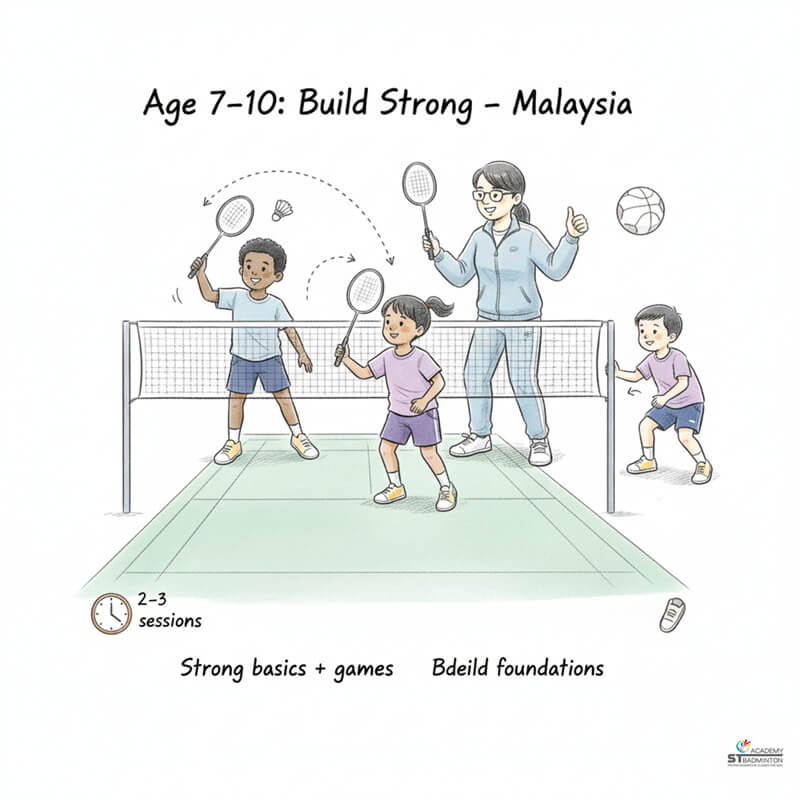
The Structured Approach
When “Big Group” Can Still Work
Big group badminton training is not inherently bad, but its effectiveness hinges entirely on excellent organisation. For a large class to succeed, it must feature clear sub groups based on skill level, have multiple attentive assistant coaches, and use a circuit of different drill stations to keep every child active.
This system ensures children are constantly moving and practicing, not just waiting in a long queue for their turn to hit a single shuttle. A well run big group feels energetic and productive.
This format is suitable for general fitness blocks, large scale footwork exercises, or sparring days for older, more independent teens. However, without this strong structure, the significant risk is that many children receive very little individual correction, allowing mistakes to go unnoticed.
Families in Cheras or Air Panas might find large classes convenient but should always observe a session first to confirm it is managed properly and not just chaotic.

Small Group vs Big Group Badminton Class
How to Check the Real Coach to Student Ratio
The advertised badminton coaching ratio for children can often be misleading. When you visit a potential academy, observe what is actually happening on the court. Is the head coach actively teaching and correcting students, or are they just watching from the sidelines?
Are the assistant coaches engaged, feeding shuttles, and providing constructive feedback, or do they look bored and uninvolved? A great sign is when you hear kids being corrected by name “Sarah, keep your racket up!” frequently throughout the session.
Also, analyse the drills: is there a system that keeps everyone moving, or do you see a lot of idle waiting time? This tells you everything about the class’s real value.
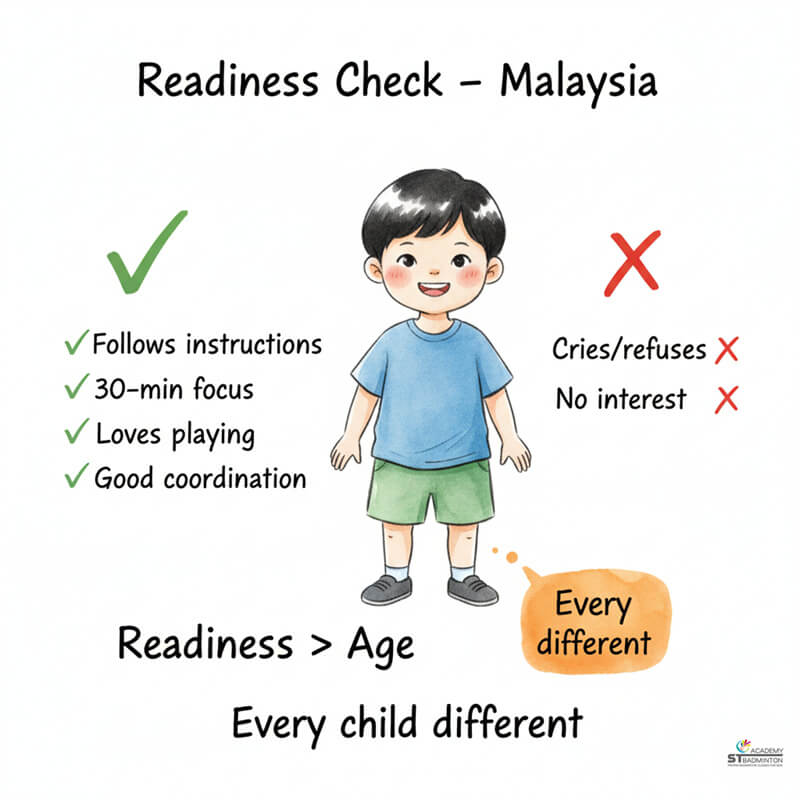
Structure & Safety
Grouping, Progression & Safety First
Regardless of size, a high quality class must have clear and sensible grouping by both age and current skill level. It is unsafe and unproductive to have small, young beginners on the same court as powerful, competitive teenagers.
Look for a professionally structured session that always includes a proper warm up and a dedicated cool down. The head coach must enforce clear rules about court spacing and safe shuttle feeding distances to prevent accidental injuries.
A well defined weekly plan is another sign of a good program, showing progression from basic skill building to controlled drills and eventually into small, competitive games. A thoughtful coach will also know to adjust the training load during stressful exam weeks and ensure children have sufficient rest days to recover, preventing both physical injury and mental burnout.

Logistics & Fit
Court Time, Schedule & Location Fit
When you evaluate different classes, always consider the net active minutes per child, not just the advertised session length. A 90 minute class where a child spends most of the time waiting in line is far less effective than an intense 60 minute class filled with constant movement, drills, and personalised feedback. Look for a programme that values quality of time over sheer quantity.
For parents, travel time is a significant practical consideration. Families travelling from Selayang, Kepong, or dealing with traffic from Cheras must be realistic.
Committing to a “famous” but crowded academy far away can lead to chronic fatigue and burnout for both child and parent. Very often, a nearby, well managed small group class offers better and more sustainable progress in the long run by saving valuable time for rest and homework.
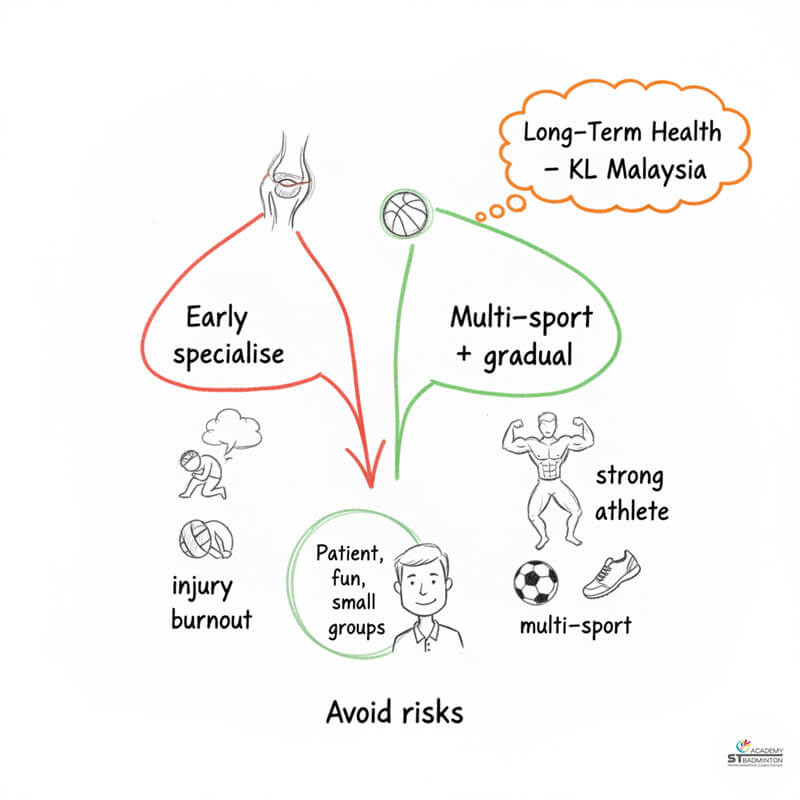
Making the Investment
Fees, Value & What’s Included in the Price
When you enquire about class fees, always ask for a detailed breakdown of what is included. Does the price cover monthly or term based coaching, court rental fees, shuttlecocks, a one time registration fee, and a team jersey?
The true value of a badminton class is not determined by its price tag alone; it is a formula: (Coach Quality + Coach Ratio + Active Court Time + Training Plan) ÷ Cost. A cheap class with no progress is not good value.
Parents should be cautious of the two extremes: the “cheap but crowded” classes where little is learned, and the “expensive but idle” classes where kids spend too much time waiting. The best value for your investment comes from a programme where your child is consistently engaged, learning correct techniques, and genuinely enjoying the entire process.
FAQs: Choosing the Right Badminton Class Size
Here are answers to common questions from Malaysian parents about choosing between small group and big group badminton classes for their children.
What class size is best for beginner kids’ badminton in Kuala Lumpur?
For most beginners in Kuala Lumpur, a small group of 4 to 8 students per coach is the ideal starting point. This recommended badminton class size for kids ensures they receive sufficient personal attention to master the correct grip, footwork, and basic strokes from the very beginning. A low badminton coaching ratio for children is vital to prevent the formation of bad habits that become much harder to correct later on. While larger groups can seem more social, the lack of individual feedback can significantly slow down a beginner’s fundamental progress.
My child is shy will a small group help more than a big class?
Yes, a shy or quiet child will almost always benefit more from small group badminton coaching. The less intimidating and calmer environment makes it much easier for them to interact with the coach and feel comfortable asking questions. A skilled coach in a small setting can provide gentle, consistent encouragement to build their confidence step by step. In a large, noisy class, a shy child might feel overwhelmed or overlooked, causing them to hesitate and withdraw, which hinders both their skill development and overall enjoyment of the sport.
Can big group badminton training still be effective for older kids?
Big group training can certainly be effective for older or more advanced kids, but its success depends entirely on its structure. It works very well for stamina building fitness drills, large scale footwork circuits, and match play sessions where players can rotate partners frequently. The key is having multiple coaches or well defined stations to maintain high intensity and eliminate long periods of waiting. Without this level of organisation, a big group can become unproductive. For focused technical refinement, however, even older players benefit most from smaller group settings.
How do parents in Selayang or Kepong balance travel time and class quality?
For parents residing in areas like Selayang and Kepong, balancing the commute to Kuala Lumpur with class quality is a practical challenge. It is often more beneficial to choose a closer, well run small group class than to travel a long distance for a famous but overcrowded academy. A child who is tired from traffic cannot learn effectively. Aim for a sustainable balance: a reasonably located class with a good coach to student ratio will yield more consistent, long term progress and prevent burnout from excessive travel, especially on school nights.
Are higher fees always better, or is coach ratio more important?
Higher fees do not automatically equate to better quality. The badminton coaching ratio for children is a far more reliable indicator of value. For instance, a class in Cheras might be cheaper but have 15 kids with only one coach, resulting in minimal personal feedback. A slightly more expensive class with a 1:6 ratio will deliver vastly better results and faster improvement. Parents should define ‘value’ by the coach’s experience, the amount of individual attention their child receives, and the overall structure of the training, not just the monthly fee.
What should I watch during a trial class to judge quality?
During a trial class, try to ignore the fancy drills and focus on two core things: student engagement and coach correction. Are all the kids actively participating and moving, or are many of them just standing in line waiting? More importantly, how often does the coach speak directly to each child by name to correct a mistake or offer praise? A good coach, whether in Air Panas or central KL, will be constantly scanning the group and providing quick, specific feedback. This is the key difference between simple supervision and effective coaching that leads to real improvement.
Small Group vs Big Group Badminton Classes in Action
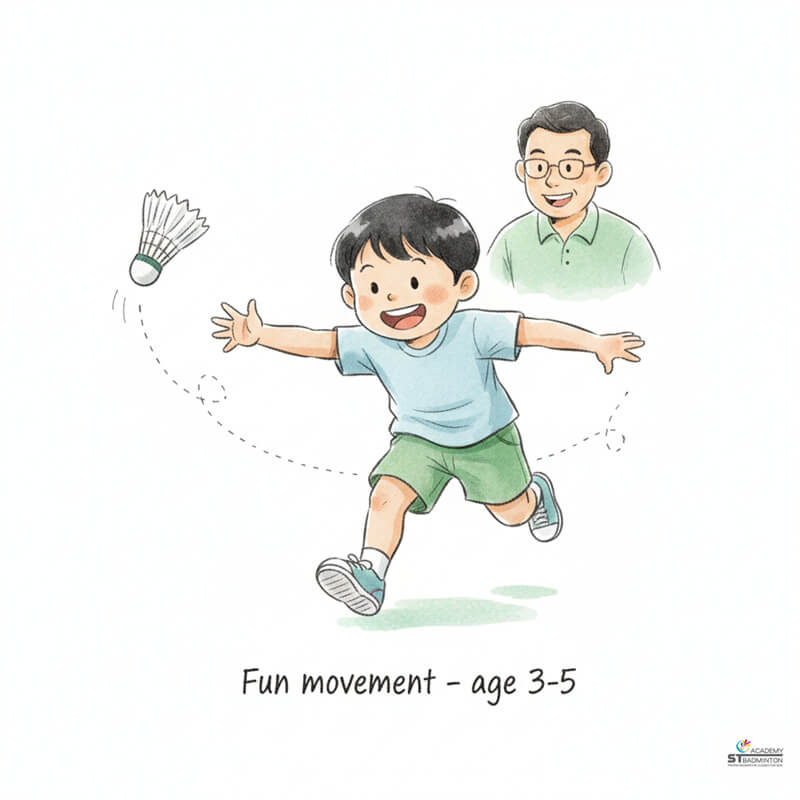
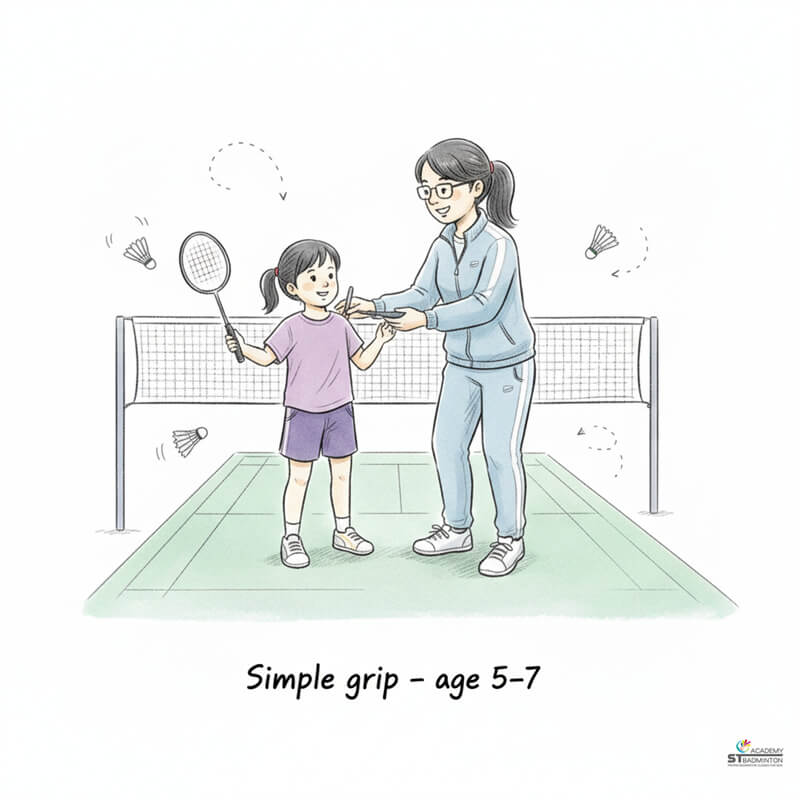

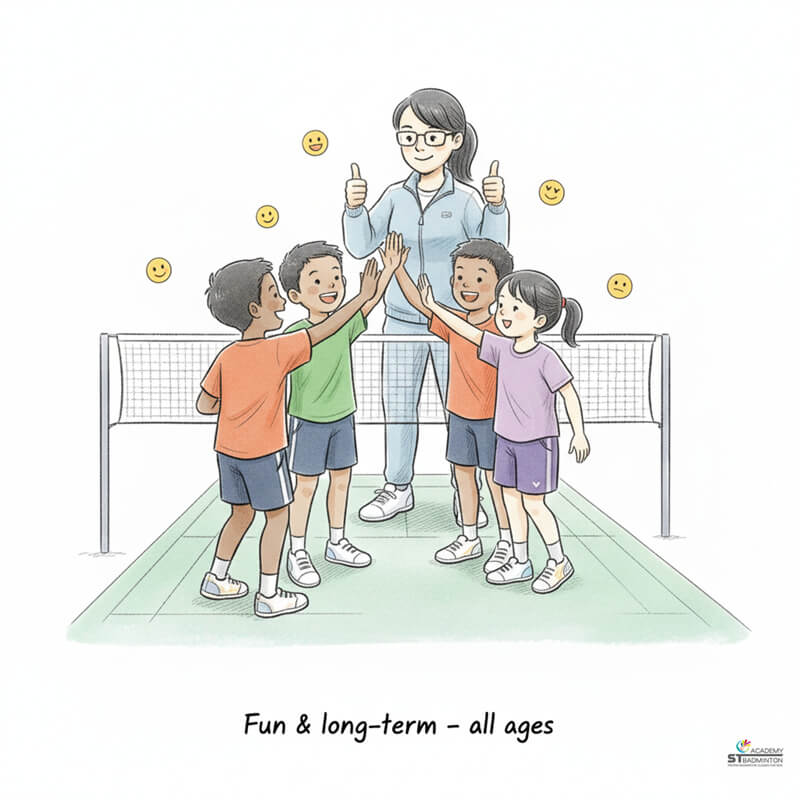
Checklist for Parents: How to Choose the Right Class
Use this simple checklist to evaluate any kids badminton class in Malaysia. It will help you see past the marketing and decide if a programme is the right fit for your child's development, safety, and your family's schedule.
| Factor | Big Group Class (~10+ students) | Small Group Class (~4-8 students) FASTER PROGRESS |
|---|---|---|
| Feedback Per Child | Low. Coach has limited time for each child, so corrections are often generic. | High. Frequent, personalised corrections help fix bad habits quickly. |
| Coach Ratio | Often 1 coach to 10+ students. Assistants may lack experience. | Usually 1 coach to 4-8 students, allowing for focused attention. |
| Court Time | Can be low due to long queues for drills. Less shuttle touches per session. | High. More active time hitting shuttles and less time waiting around. |
| Safety & Supervision | Harder to monitor every child, increasing risk of accidental hits. | Easier for the coach to ensure safe spacing and proper technique. |
| Best For | General fitness, basic footwork circuits, and social interaction for outgoing kids. | Beginners, shy children, and any player needing to fix technical skills. |
| Pace of Learning | Slower for technical skills, as individual mistakes may be missed. | Faster for building a strong technical foundation and correcting errors. |
| Cost | Usually lower per session, which can be attractive for budget-conscious families. | Typically higher per session, but offers better value in terms of progress. |
Find Quality Kids Badminton Classes in Kuala Lumpur
This guide has been designed to help you confidently compare the small group vs big group badminton class options for your child. Making an informed choice now sets the stage for a positive and successful sporting journey. When you are ready, our badminton academy for kids in Malaysia provides professional, small group coaching that prioritises building a strong and correct technical foundation. If you are looking for quality kids badminton classes in Kuala Lumpur, including areas like Setapak, Wangsa Maju, and Cheras, please contact us to learn more about our training structure and class schedules.




